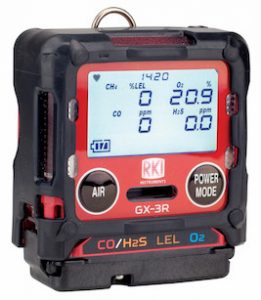Nothing is more important for safety than monitoring for toxic and explosive gases, but many workers in manufacturing facilities do not know the best practices that keep everyone safe.
Toxic and explosive gases can quickly leak from failed equipment or gas lines and collect in confined spaces. Unless they are detected, the results of trapped gases can be explosions, fires, asphyxiation or exposure to contaminants.
Every manufacturing facility has an obligation to protect workers from these hazards. Making these mistakes can put your crew and facility at risk.
Not Understanding the Difference Between Gases
 If you aren’t certain which types of gases to look for, you can’t properly monitor them. Conduct a risk assessment before you shop for gas detection equipment. Identify potentially harmful gases, oxygen deficiency risks and vapor hazards. This knowledge will help you understand which monitors are best for your needs.
If you aren’t certain which types of gases to look for, you can’t properly monitor them. Conduct a risk assessment before you shop for gas detection equipment. Identify potentially harmful gases, oxygen deficiency risks and vapor hazards. This knowledge will help you understand which monitors are best for your needs.
For example, the most common gases include methane, carbon monoxide, pentane and hydrogen sulfide. A four-gas monitor with sensors for these gases would be ideal for monitoring a space with these hazards. If other volatile gases like toluene or acetylene are present, that standard four-gas monitor would be insufficient.
For over 80 years, RKI Instruments has been at the forefront of sensor technology, developing advanced detection techniques to provide solutions for specific applications. As a result, RKI provides reliable, rugged gas detection equipment. Through ingenuity and years of industry experience, RKI has developed a unique line of gas detection interments and accessories, and we are proud to offer them to you here at Haaker Underground. Click here to view our gas detection equipment and schedule your free demo!
Not Performing Routine Gas Detector Maintenance and Bump Tests
Just using gas monitors regularly isn’t enough — your team also needs to be regularly bump testing and calibrating the equipment. These steps ensure the monitor’s alarm is functioning and that gas is being monitored accurately. Conduct these tests each day before use to ensure your equipment is working properly.
Not Following Safety Plans After an Alarm
Safety practices also need to be regularly enforced. Gas alarms are not a nuisance; they are a potentially life-saving measure that must be heeded. Safety protocols should always be followed after an alarm.
If alarms are sounding so often they become a nuisance, address the situation. Review your environment and equipment to determine the cause of alarms and consider whether your monitor needs replacing or adjusting. Simply ignoring alarms can never be an option.
